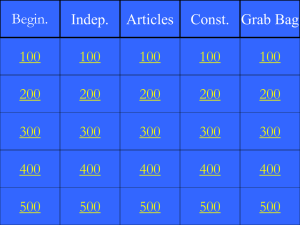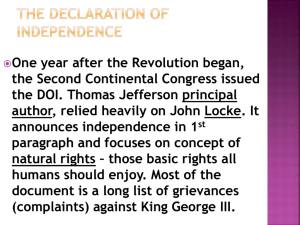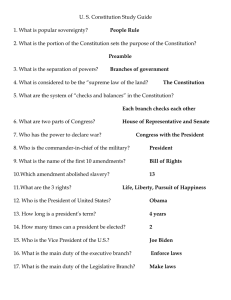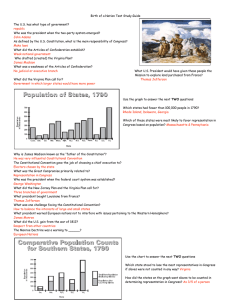Ch. 6 The Constitution
advertisement
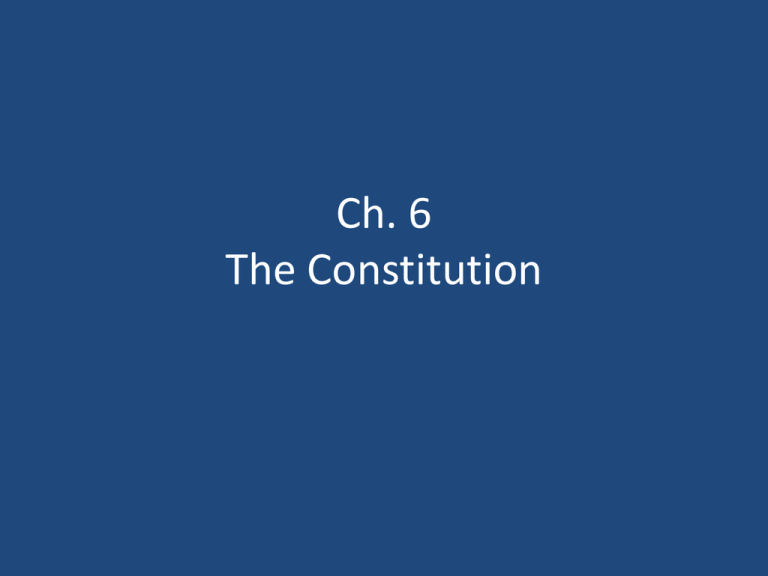
Ch. 6 The Constitution The Weak Confederation • Problems with the Articles – Barely approved the Treaty of Paris with Great Britain • Couldn’t effectively enforce foreign aspects of the Treaty – Almost didn’t have a quorum to approve the Northwest Ordinances regarding territory acquired through the treaty. • Only 8 states even voted – Couldn’t regulate international trade, hurt merchants • Positives – They won the Revolution with it – Most people liked the idea of strong government in each state. Calls for Reform • Even supporters of the Article agreed changes needed to be made, how drastic though? • Alexander Hamilton – Political and Economic genius, New York lawyer – Led the charge for reform and convinced James Madison to sell the idea to Virginia Legislature • Reform gains credibility – They needed George Washington’s support in order for all states to get involved – Shays’s Rebellion convinced even Washington that the time had come. The Constitutional Convention • Met in Philadelphia from May to September 1787 • 55 delegates from every state except Rhode Island – Washington was unanimously chosen as President of the Conference – John Adams was in England for diplomatic reasons – Jefferson was in Paris also – Patrick Henry refused to attend, he fully supported the Articles • Each state would only have one vote on issues regardless of the number of delegates. Convention Continued • While they initially met to investigate changes to the articles, it was soon decided to simply create an entirely new Constitution • They met in secrecy, not allowing the opportunity for outside influence – The journal entries of James Madison serve as the only written documentation of the meetings. • Virginia had the most prepared group of delegates – James Madison arrived with a plan already prepared. – His “Virginia Plan” devised most of what is today‘s American government. The Virginia Plan • Called for Three separate Branches of Government – Legislative Branch: consisted of a two House Congress where each state represented according to population – Executive Branch: led by a President who enforced Congressional laws. – Judicial Branch: Supreme Court to approve laws and enforcement. • The plan greatly favored larger states • Under the design, some smaller states wouldn’t have any representation in upper house of Congress. The New Jersey Plan • More closely resembled the Articles – Called for a One House legislature where each state would have equal representation. • Major changes: – Congress could now have the ability to tax the people directly – Congress could regulate international trade – Only “Federal” government could print currency • Larger States did not like the New Jersey Plan The Great Compromise • Committee led by Ben Franklin to devise a solution since the Convention was about to fall apart. – They devised the Connecticut Compromise, because it was proposed by Roger Sherman of Connecticut – Better known as Great Compromise. • Resembled much of the Virginia Plan – Two House Congress • Senate –upper house of Congress and each state would have TWO Senators, thus equal representation • House of Representatives –lower house where each state’s representation depended upon population The 3/5 Compromise • Southern states wanted to count their slaves to gain representation in House of Reps. • Northern States opposed this idea – Slaves were considered property, they couldn’t vote, hold land, nor were they citizens – Northern states didn’t have them • Compromise allowed them to count 3 of every 5 slaves, thus pacifying southern states, but not completely giving in. Sovereignty and Separation of Powers • The most important issue became the question of Sovereignty – Who had more power, state governments or Federal • Result was to give the most power to neither – All power would derive directly from the people. – All levels of government would be subject to vote form the people. • Preamble confirms the idea – Written by Robert Morris – Begins with “We the People… “ for a reason Distribution of Powers • Most distinctive feature of the Constitution • Constitution is “Supreme Law” of the land, and no single state could defy it. – Federal Government had broad powers • Expressed or Implied Powers: Power to tax, regulate commerce, regulate currency, and pass any law necessary and proper for it to carry out duties. – Recognized individuality of each state • Reserved Powers: Allowed for each state to retain power, jurisdiction, and rights not expressly delegated to Federal government. Distribution of Power Cont. • Complex passage of laws through Congress – Senate and the House had to approve laws separately – Each with members selected differently and with different terms to ensure no faction could dominate the process. • Emphasis placed on taking every precaution against possible tyranny Checks and Balances • President (Executive Branch) had to agree to any laws passed through both Houses by signing it – President could veto any bill by refusing to sign • Congress could override any Presidential veto with a 2/3 majority vote. • Federal courts would be responsible to interpret the Constitution and prevent the passage of any law or enforcement deemed unconstitutional. • President appointed all federal judges, and Senate had to approve them – Judges are the only members of Federal government not elected by the people with life terms. Ratification • Convention members were concerned states would reject the new Constitution – They exceeded what Congress authorized them to do • Each state would be instructed to hold individual Conventions to consider it – Legislatures would not be involved • Ratification would require 9 of the 13 states – The Articles required all 13 • No changes, or “amendments” could be made until after it was ratified. Federalists vs. Anti-Federalists • Federalists – those in support of the new Constitution and a stronger national government. – Radical new ideas, but supported by the most prominent Americans like Washington & Franklin • Federalist Papers – series of essays defending the Constitution and explaining its merits – Published in pamphlets and papers throughout the states, especially ones like New York where ratification was in doubt – Written predominantly by Alexander Hamilton, James Madison, and John Jay under the pseudonym “Publius” Anti-Federalists • Opponents of the new Constitution – Felt it betrayed many of the principles of the Revolution – Allowed the opportunity for a government to become tyrannical – Would increase taxes – Favor wealthy over majority • Largest Complaint: – No Bill of Rights specifically outlining individual guaranteed rights. • Read Page 167 (Debating the Constitution) Constitution Ratified • Winter 1787-1788: States bitterly, but quickly debated the new document – Delaware was the first to ratify, soon followed by many others – By June 1788 New Hampshire became the 9th state to ratify, thus making it official • Concern still grew with New York and Virginia in debate – With ratification from those two later in the month Americans became more confident in the new Constitution.

